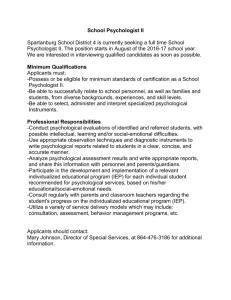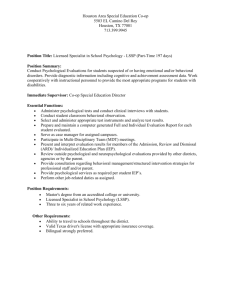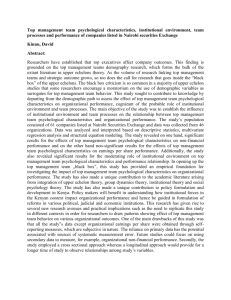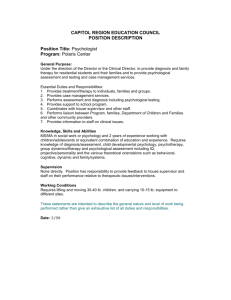PSYCHOLOGICAL tests aren`t magic, so let`s get that clear right at
advertisement
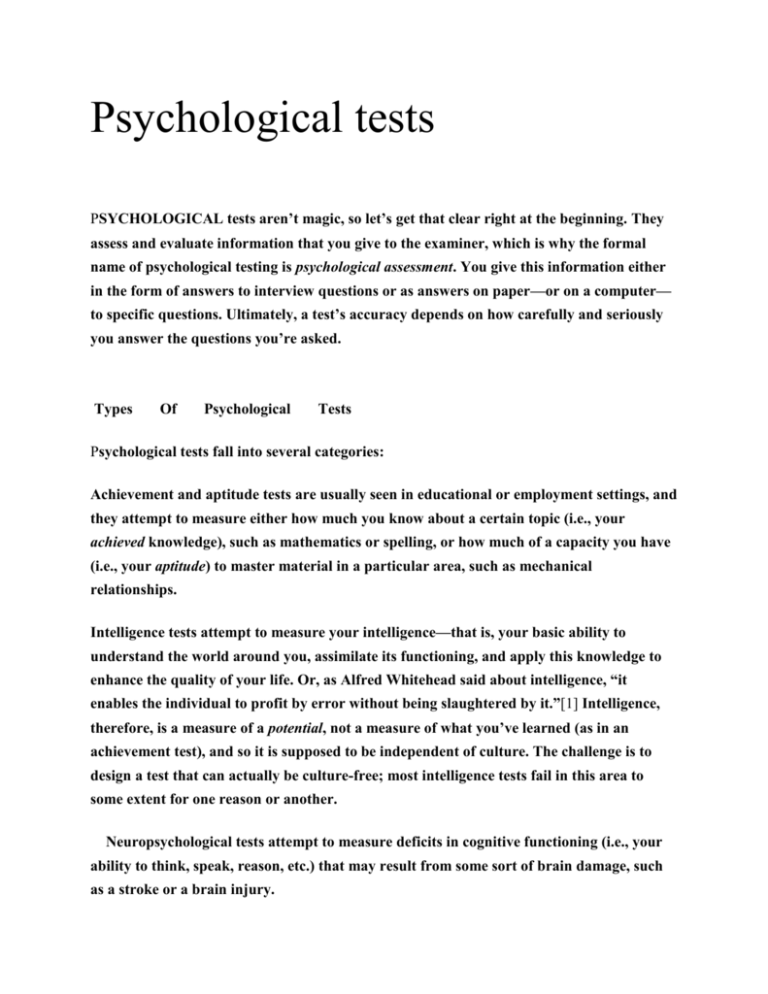
Psychological tests PSYCHOLOGICAL tests aren’t magic, so let’s get that clear right at the beginning. They assess and evaluate information that you give to the examiner, which is why the formal name of psychological testing is psychological assessment. You give this information either in the form of answers to interview questions or as answers on paper—or on a computer— to specific questions. Ultimately, a test’s accuracy depends on how carefully and seriously you answer the questions you’re asked. Types Of Psychological Tests Psychological tests fall into several categories: Achievement and aptitude tests are usually seen in educational or employment settings, and they attempt to measure either how much you know about a certain topic (i.e., your achieved knowledge), such as mathematics or spelling, or how much of a capacity you have (i.e., your aptitude) to master material in a particular area, such as mechanical relationships. Intelligence tests attempt to measure your intelligence—that is, your basic ability to understand the world around you, assimilate its functioning, and apply this knowledge to enhance the quality of your life. Or, as Alfred Whitehead said about intelligence, “it enables the individual to profit by error without being slaughtered by it.”[1] Intelligence, therefore, is a measure of a potential, not a measure of what you’ve learned (as in an achievement test), and so it is supposed to be independent of culture. The challenge is to design a test that can actually be culture-free; most intelligence tests fail in this area to some extent for one reason or another. Neuropsychological tests attempt to measure deficits in cognitive functioning (i.e., your ability to think, speak, reason, etc.) that may result from some sort of brain damage, such as a stroke or a brain injury. Occupational tests attempt to match your interests with the interests of persons in known careers. The logic here is that if the things that interest you in life match up with, say, the things that interest most school teachers, then you might make a good school teacher yourself. Personality tests attempt to measure your basic personality style and are most used in research or forensic settings to help with clinical diagnoses. Two of the most well-known personality tests are •the Minnesota Multiphasic Personality Inventory (MMPI), or the revised MMPI2, composed of several hundred “yes or no” questions, and •the Rorschach (the “inkblot test”), composed of several cards of inkblots—you simply give a description of the images and feelings you experience in looking at the blots. Specific clinical tests attempt to measure specific clinical matters, such as your current level of anxiety or depression. Psychological tests are usually administered and interpreted by a psychologist because studies in psychopathology, along with academic courses and supervision in psychological testing, are an integral part of the doctoral degree in clinical psychology. A counselor who has had the appropriate academic courses and supervision may administer occupational tests or achievement and aptitude tests, but most counselors have not received the training to administer personality tests. Academic courses and supervision in psychological testing are usually not a part of a psychiatrist’s medical training, so most psychiatrists can ethically administer only some specific clinical tests that are straight-forward check-lists of symptoms. Of course, ethics is one thing, and the desire to make money is another thing. Therefore you will often find individuals offering to do all kinds of psychological testing—especially on the Internet—even when they lack the professional training to administer and interpret such tests. So, as in all things, buyer beware. Justifications For Using Tests Psychological tests were created for three main reasons, all of which are interconnected: It’s easier to get information from tests than by clinical interview. Most people won’t talk about this, but, believe it or not, many psychologists are rather inept at dealing with people, and so it’s a great relief to them to be able to administer a test rather than conduct a competent interview. Thankfully, such psychologists tend to specialize in testing (or research, or teaching) rather than psychotherapy. Think about this if ever you find yourself sitting in front of a steely-eyed psychologist while being given a battery of psychological tests. The information from tests is more scientifically consistent than the information from a clinical interview. If a psychologist is simply trying to arrive at a diagnosis to help determine the course of psychotherapy, an interview is just fine. But when decisions have to be made about legal matters, disability issues, and so on, then the standardized information from tests allows one person to be directly compared with others, and it makes things more fair. It’s harder to get away with lying on a test than in a clinical interview. Many tests have multiple “alarms” that go off when a test taker tries to lie. And some tests, such as the Rorschach (the “inkblot test”) don’t even give a clue as to what preferred, or healthy, responses might be, so it’s pretty much impossible to make yourself “look good” by fabricating deceptive answers to a test like this. Validity and Reliability The overall problem with psychological tests concerns their ability to measure what they are supposed to measure. The accuracy, or usefulness, of a test is known as its validity. For example, suppose you wanted to develop a test to determine which of several job applicants would work well in a bank. Would an arithmetic test be a valid test of job success? Well, not if the job required other skills, such as manual dexterity or social skills. •Construct Validity refers to the ability of a test to measure the psychological construct, such as depression, that it was designed to measure. One way this can be assessed is through the test’s convergent or divergent validity, which refers to whether a test can give results similar to other tests of the same construct and different from tests of different constructs. •Content Validity refers to the ability of a test to sample adequately the broad range of elements that compose a particular construct. •Criterion-related Validity refers to the ability of a test to predict someone’s performance on something. For example, before actually using a test to predict whether someone will be successful at a particular job, you would first want to determine whether persons already doing well at that job (the criterion measure) also tend to score high on your proposed test. If so, then you know that the test scores are related to the criterion. The ability of a test to give consistent results is known as its reliability. For example, a mathematics test that asks you to solve problems of progressive difficulty might be very reliable because if you couldn’t do calculus yesterday you probably won’t be able to do it tomorrow or the next day. But a personality test that asks ambiguous questions which you answer just according to how you feel in the moment may say one thing about you today and another thing about you next month. •Internal Consistency Reliability refers to how well all the test items relate to each other. •Test-retest Reliability refers to how well results from one administration of the test relate to results from another administration of the same test at a later time. Note that without reliability, there can be no validity. A thermometer, for example, may be a valid way to measure temperature, but if the electronic thermometer you are using has bad batteries and it gives erratic (that is, unreliable) results, then its reading is invalid until the batteries are changed. Note also that no psychological test is ever completely valid or reliable because the human psyche is just too complicated to know anything about it with full confidence. That’s why there can be such uncertainty about a case even after extensive testing. “Stretching” Validity: The MMPI and Occupational Screening A classic problem with validity arises when someone uses a test for a purpose for which it was not designed. The MMPI, for example, was designed to measure pathological personality traits, yet it (or the MMPI-2) is often used as a screening tool for law enforcement, seminary students, firefighters/paramedics, airline pilots, medical/psychology students, and nuclear power facility workers. Many persons therefore wonder if this is an appropriate use for the test. Common sense can tell us what personality characteristics make good police officers, for example. They should have good self-esteem, yet not overvalue themselves. They should be energetic, yet not be so involved with so many activities as to be ineffective. They should have good impulse control and be able to tolerate insult without becoming irritable. They shouldn’t hold personal grudges but should be fair, and kind, and objective. They should be obedient to authority and yet be able to make good judgments independently. They should have stamina when under threat. And so on. But these are complex qualities. How do you measure them? For example, you could ask a person if he is honest, and he would likely say, “Yes.” But real honesty is discovered under temptation to be dishonest. If hiding a detail of a case could save your career, what would you do under that kind of pressure? Well, there’s no psychological test that can measure any of this. The real “test” is in the encounter with life itself. So, when trying to select good candidates for police officers, if it’s too difficult to “select in” good traits, then the next best option is to “select out” obvious negative qualities. And that’s where the MMPI-2 comes in. This psychological instrument measures levels of psychopathology. It can tell if someone is always depressed, has bizarre ways of thinking, is always complaining about health problems, or is socially inhibited or overly aggressive, and so on—those sorts of things. Now, anyone with common sense can tell that someone who is free of obvious negative traits won’t necessarily make a good police officer—or be good at any specific career, for that matter. There’s a lot more that goes into any career than a freedom from psychopathology. Still, the MMPI-2 can be used as a rough screening device to eliminate some obvious problems. However, if the MMPI-2 alone were used for candidate selection, its validity would be stretched way beyond reason, and some serious mistakes would be made. On the one hand, many candidates without obvious psychopathology—but who still don’t have all the “right stuff”—would be accepted anyway. On the other hand, candidates with some scale elevations could be eliminated even if they may have been functioning well in life so far; in fact, moderate elevations on some scales can be good things in certain situations. This is why a competent psychologist has to make an interpretation of the overall MMPI-2 profile and consider the profile in light of other historical information, such as previous job performance, academic performance, letters of recommendation, and so on. And this decision-making process brings up one final issue. False Negatives and False Positives The sole reason for using psychological tests is to help answer the question, Do we accept this person or not? And since psychological tests aren’t magic, mistakes will be made. Even when a qualified psychologist makes a decision based on all the available evidence, there will still be doubts and shadows of doubts. Thus a false negative mistake occurs when a person truly qualified for a job is rejected; a false positive mistake occurs when a person not truly qualified for a job is accepted. Lie Detection The lie detector has a certain mystique about it because it is often used in criminal justice or high security settings. And even though it is not a true psychological assessment instrument, it does utilize some psychological principles. In fact, these principles are the same as the principles used in biofeedback. The typical lie detector, like a biofeedback instrument, simply measures many different physiological processes such as heart rate, respiration, blood pressure, skin temperature, and skin conductance. Hence its technical name, the polygraph, a word composed of poly(from the Greek poly, many) and -graph (from the Greek graphos, writing) in reference to the instrument’s multiple recording channels. In biofeedback, these various physiological processes are “fed back” to you as sounds or computer-generated displays that you can use to learn to alter your overall physiological experience in the direction of deep relaxation. But a lie detector does something different: it doesn’t tell you a thing about your physiological reactions. The reactions are measured and recorded, all right, but the test administrator sees them, not you. So how does a lie detector detect a lie? Well, the test administrator simply asks you various questions and watches your physiological responses as you answer the questions. Some questions are neutral questions, such as “What is your name?” and your response in answering these questions should be quite relaxed. Then the administrator throws in the real questions. “Are you really a double agent?”—things like that. If you can truthfully answer “No,” then your physiology will likely remain relaxed. But if you lie while saying “No,” then those little recording needles will jump all over the place simply because all the unconscious conflicts you experience in telling a lie have subtle physiological consequences. So on the one hand it’s all quite simple. But on the other hand, it’s more an art than a science. Just how much do those needles have to jump around to indicate that you’re lying? Well, there’s no clear-cut answer; the test administrator has to make a subjective judgment based partly on science and partly on experience. And that is why lie detector results can be so controversial. Mistakes can be made. When does anxiety, for example, get mistaken for lying? And when does someone with “nerves of steel” get away with lying? The only one who knows for sure is the one taking the test, and psychology has not yet learned how to do mind-reading. Science And Pseudoscience In its original sense, science (from the Latin scire, to know) simply meant the state or fact of knowing, as compared to intuition or belief. The current technical sense of the word, however, refers to knowledge obtained from systematic observation, study, and experimentation. Now, as I said above, psychological tests aren’t magic; most of them have been developed through sound scientific principles. In fact, anyone who wants to become a psychologist must learn all the scientific principles of test construction; even if a psychologist has no desire to create a new test, he or she must be competent to evaluate the scientific value of any specific test before using it clinically. Unfortunately, there are many psychological tests in wide use that are accepted as being scientific just because they are called “tests.” For example, the Myers-Briggs Type Indicator and the Enneagram, often used in educational and corporate personnel settings to assess personality “types,” are based in pseudoscience and psychobabble and have about as much worth in clinical settings as astrology. Any competent psychologist can use intuition to get as much information as these “tests” provide. And then there is the classic Rorschach test that uses inkblots to assess a person’s inner psychological experience. Several methods for administering and scoring the Rorschach have been developed, and although some of them are surrounded with a considerable amount of published research, it would be surprising if any two independent psychologists could administer the Rorschach to the same person and achieve identical findings. Similarly, tests such as the Thematic Apperception Test (TAT), which asks a person to tell stories about various pictures of social interactions, and the Draw-A-Person and HouseTree-Person, which ask a person to draw pictures, are not usually objectively scored and give results of questionable validity. In the end, then, psychological testing can, in some ways, be both valid and reliable; yet, in other ways, it often does not achieve much more than an impressionistic evaluation of a person. And often the science and the pseudoscience are quietly mixed together in one “scientific” report. Cautions Psychological test scores can be very useful under the proper circumstances—and when the limitations of psychological testing are properly understood and respected. Note, however, that the score you get on any psychological test is nothing more than “the score you have gotten on that test.” Let’s say you took an IQ test and got a score of 126. Well, your IQ test score may be 126, as measured by that test, at that time, under those circumstances. But what is your real IQ? Well, no one knows. And that’s a fact. So what does an IQ test really measure? Well, again, no one knows. And that’s another fact. Note also that every well-known and widely used psychological test in the US was developed and standardized in English. This might not seem very important, but just consider what happens when someone needs to be tested who doesn’t speak English fluently. If the test is translated into another language—either in print or through a translator—all kinds of problems can occur. English words with multiple meanings cannot be adequately translated. English idioms cannot be expressed in another language without changing the entire sentence structure along with the underlying logic of the sentence—and when that happens standardization, and the guarantee of fairness it promises, is lost. So, even though translated versions of tests might be used, and even though you might be given a score that appears to be official and scientific, that score is nothing more than “the score you have gotten on that test.” This might not mean much to you, and it might seem like philosophical quibbling. But what if your life depended on that score? Your Rights If ever you find yourself being given a psychological test, remember that you have all the rights of a consumer, as well as the right •to know the purpose of the testing; •to know the names of, and rationales for, the tests being used; •to know the results of the testing (you even have the right to read the psychological report itself); •to determine, through your signed release of information, who will have access to the testing information (interview information, raw scores, test reports) in your chart.
